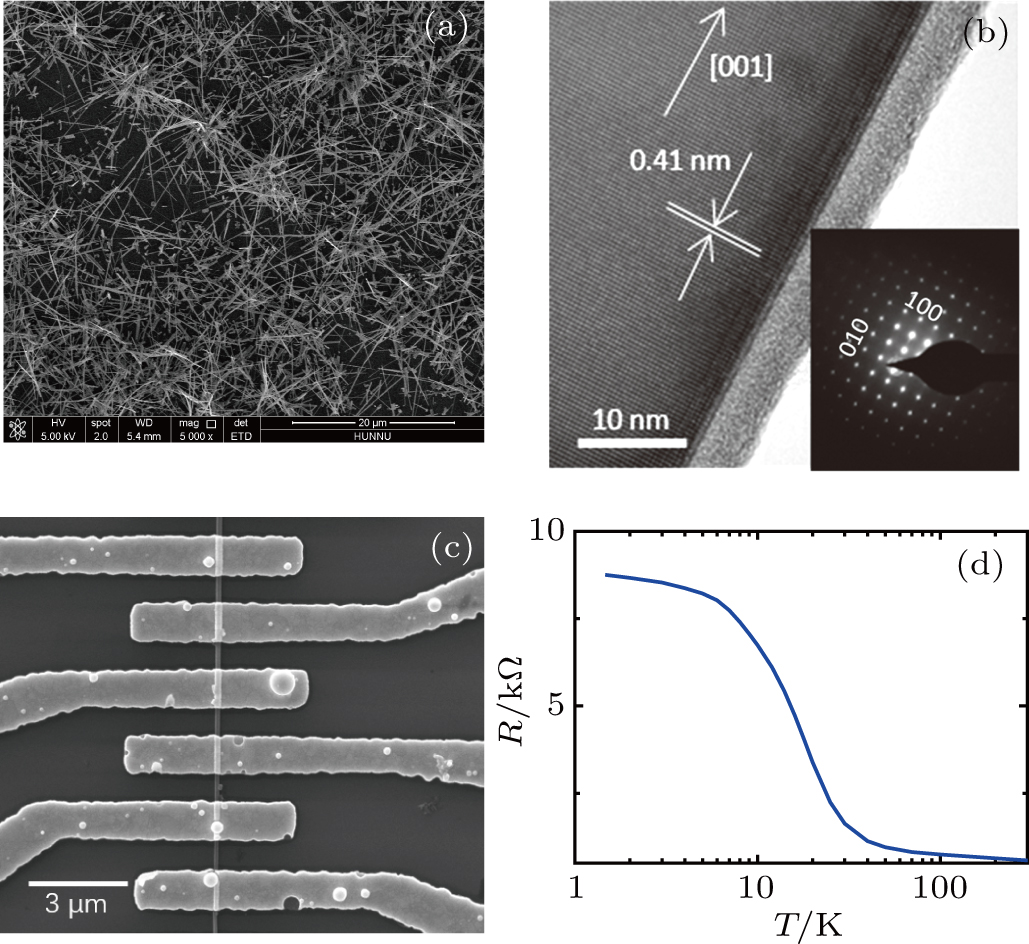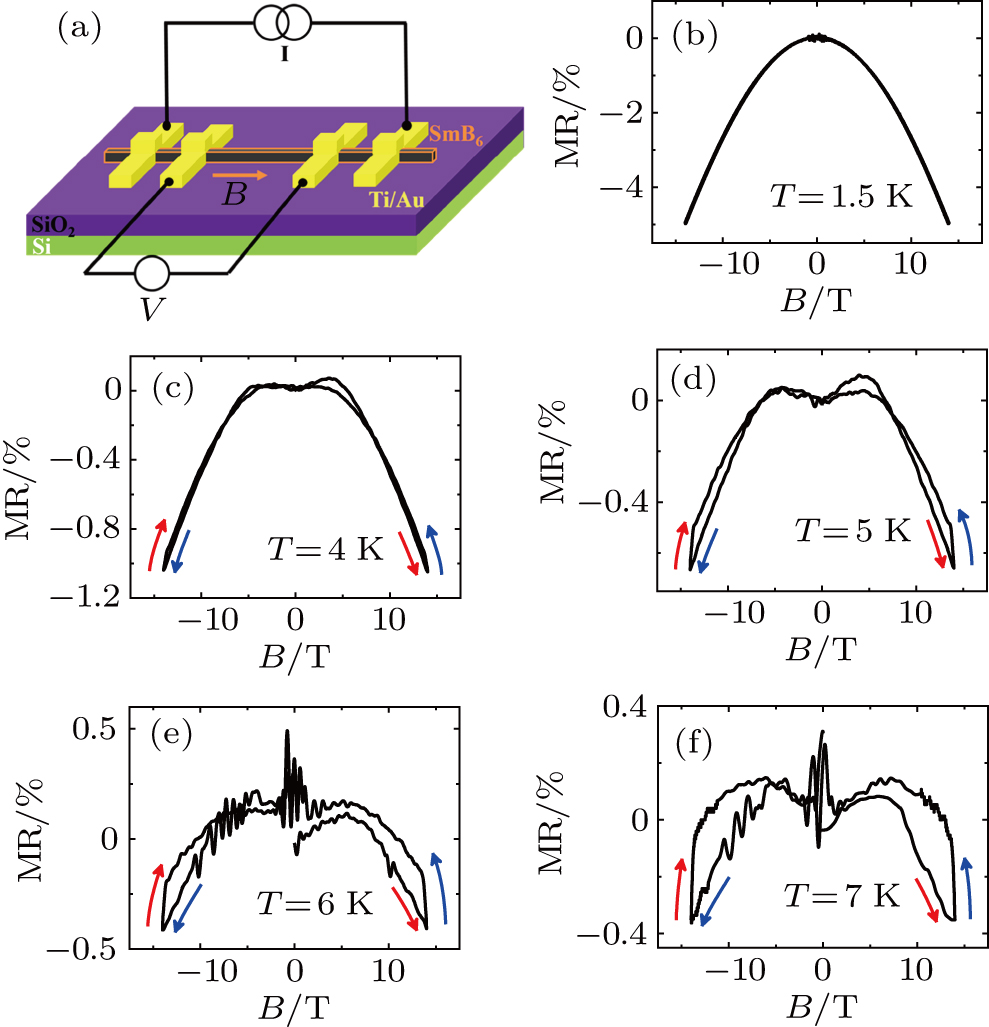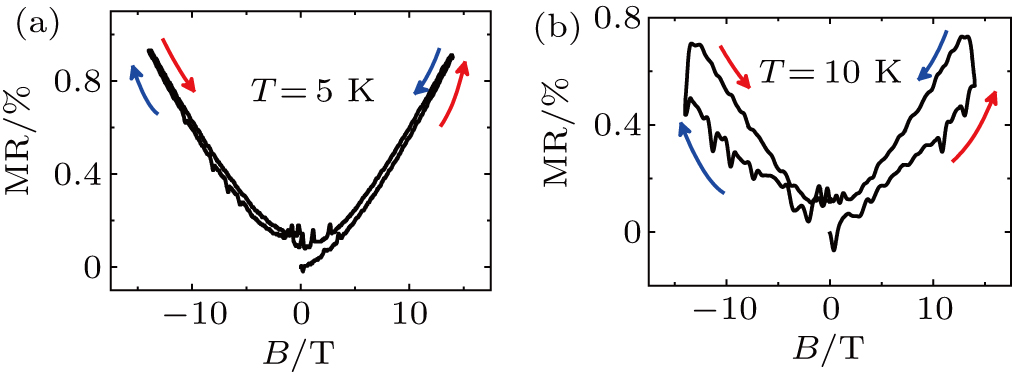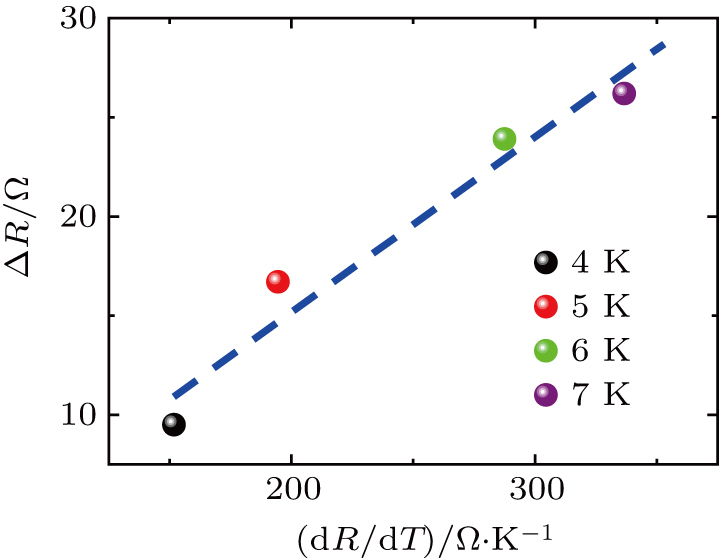† Corresponding author. E-mail:
Project supported by the National Key Research and Development Program of China (Grant No. 2016YFA0300802) and the National Natural Science Foundation of China (Grant Nos. 61825401 and 11774004).
SmB6, a topological Kondo insulator, with a gapped bulk state and metallic surface state has aroused great research interest. Here, we report an exotic hysteresis behavior of magnetoresistance in individual SmB6 nanowire in a temperature range in which both surface and bulk states contribute to the total conductance. Under a magnetic field parallel to the SmB6 nanowire, the resistance suddenly increases at the turning point from up-sweep to down-sweep of the magnetic field. The magnetoresistance hysteresis loops are well consistent with the magnetocaloric effect. Our results suggest that the SmB6 nanowires possess potential applications in the magnetic cooling technology.
SmB6, a Kondo insulator that had been investigated for several decades, was recently predicted theoretically and confirmed experimentally to be a candidate of topological Kondo insulator.[1–12] In this strongly correlated system, the hybridization of 5f electrons and 4d electrons opens a bulk gap and the spin-momentum-locked topological surface state emerges.[13,14] The spin-texture of surface states has been observed by spin-resolved angle-resolved photoemission spectroscopy (SRARPES).[15–17] Moreover, the Fermi level always lies in the gap by its Kondo insulator nature, leading to the transport behaviors dominated by surface states.[3,18–23] The transport properties of SmB6 in a low temperature range have been studied extensively, showing that the surface states dominate the transport. However, the detailed investigations in the temperature range, where both surface and bulk states contribute to transport, are still desirable. In a temperature range from 10 K to 4 K, the bulk channel is gradually closed, and the surface states emerge to remarkably influence the transport properties.
Here in this paper, we report the magnetotransport properties of individual SmB6 nanowire at temperatures ranging from 10 K to 4 K, where the resistance is very sensitive to temperature. A hysteresis loop in magnetoresistance (MR) is observed, when magnetic field direction is along the nanowire axis. When the magnetic field changes from forward to backward sweep, a sudden increase of resistance occurs. Such a resistance jump is detected both at a bias current of 

The SmB6 nanowires were grown by chemical vapor deposition (CVD) method in a tube furnace.[29,30] SmB6 nanowires were first transferred onto a Si substrate with a 285-nm-thick SiO2 layer. The Ti/Au electrodes were deposited on individual SmB6 nanowire by electron beam evaporation after removing the oxide layer from the nanowire surface by Ar-ion etching. Four terminal measurements were carried out in an Oxford cryostat via lock-in technique with a current source of 17.777 Hz.
Figure 

Figure 
It is worth noting that the MR curves show obvious hysteresis behaviors at temperatures ranging from 4 K to 7 K as shown in Figs.
To further investigate the hysteresis behavior, we perform the measurements under a bias current of 
The MR under a magnetic field perpendicular to both the substrate and the nanowire is further investigated. The measurement schematic diagram is shown in Fig. 
We should first point out that SmB6 does not have a ferromagnetic order, so the hysteresis behavior should not originate from the sample magnetism. We suggest an MCE mechanism to explain the MR hysteresis. When magnetic field is applied, the magnetic moments in SmB6 tend to be aligned and the entropy of magnetism decreases. When the magnetic field is removed, the increase of the magnetism entropy is compensated for by absorbing the phonon energy, thus leading the temperature to decrease. This makes the system temperature in the magnetic field backward sweep process lower than that in the forward sweep process. On the other hand, the SmB6 resistance increases sharply with temperature decreasing from 10 K to 4 K. This is why the hysteresis loop is much remarkable in that temperature range. Moreover, the hysteresis loop shows the same tendency under large (

To verify the mechanism of MCE, we extracted the increments in resistance (






In this work, we have observed a hysteresis behavior of MR of SmB6 nanowire at temperature ranging from 10 K to 4 K. When magnetic field is parallel to SmB6 nanowire, the resistance of SmB6 nanowire exhibits a sudden increase at the turning point from forward to backward sweep of magnetic field. We suggest an MCE mechanism to explain this phenomenon. That is, the demagnetization induces a cooling process of the system, and thus the resistance increases with temperature decreasing.
| [1] | |
| [2] | |
| [3] | |
| [4] | |
| [5] | |
| [6] | |
| [7] | |
| [8] | |
| [9] | |
| [10] | |
| [11] | |
| [12] | |
| [13] | |
| [14] | |
| [15] | |
| [16] | |
| [17] | |
| [18] | |
| [19] | |
| [20] | |
| [21] | |
| [22] | |
| [23] | |
| [24] | |
| [25] | |
| [26] | |
| [27] | |
| [28] | |
| [29] | |
| [30] |













